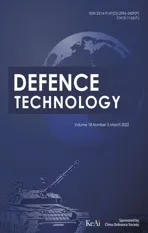Equivalent protection factor of bi-layer ceramic metal structures
2022-03-29GovindGourSridhrIdplptiWeiLingGohXiopengShi
Govind Gour ,Sridhr Idplpti ,*,Wei Ling Goh ,Xio-peng Shi
a School of Mechanical&Aerospace Engineering,Nanyang Technological University,50 Nanyang Avenue,Singapore,639798,Singapore
b School of Materials Science&Engineering,Nanyang Technological University,50 Nanyang Avenue,Singapore,639798,Singapore
Keywords:Ceramic armor Normal and NATO 60⁰impact Ballistic limit velocity Equivalent protection factor(EPF)
ABSTRACT
1.Introduction
Classical monolithic armor material is a rolled homogenous armor(RHA)which disperses the kinetic energy of the projectile through competing mechanisms based on the geometry and hardness.However,it posed limitations due to its high density,less manoeuvrability and limited protection against various types of modern threats.Hence,it has been stressed to improve the armor vehicle design with light and strong materials.For these reasons,the composite armors comprising ceramic as front face and engineering alloys as backing support have been developed.Technical ceramics with high speci fic hardness have been a favourite choice in bi-layer armor design for a high degree of ballistic performance.The energy absorbing mechanism of ceramic faced armor differs from the traditional monolithic armor.In monolithic metal armor,the energy is dissipated via plastic deformation whereas in bi-layer armor con figuration consisting ceramic as a front layer;the impact energy is firstly dissipated through formation and propagation of cracks on the ceramic surface which propagates radially and through the thickness and followed by the pushing shattered or fragmented ceramic[1,2].The primary function of hard-faced ceramic armor is to erode long rod projectile(LRP)conical head and decelerate it.The formation of cracks is known as conoid which spread the projectile energy over a large area of the backing plate,which absorbs the residual projectile energy[3].As the penetration progresses an elasto-plastic deformation of the backing plate or membrane aids in consuming the residual energy of the projectile[3,4].The inclusion of metal or fiber reinforced material support can diminish the premature failure(ceramic possesses low tensile strength)of ceramic under tensile loading.The penetration capability of the LRP reduces as the backing support aids in spreading the residual energy over a wide area.In addition,the backing support also aids in keeping chunks of ceramic in places resulting in enhancement of armor penetration resistance.
The penetration capability of the LRP can further be reduced through inclining the armor concerning the penetration path and reported that inclining armor at angles such as 45⁰,and 60improves penetration resistance[5].The rationale for this enhanced performance under oblique impact was that obliquity increase materials volume along the projectile’s path and making it dif ficult for progressive penetration:this obstructed path reduces the penetration velocity and improves the erosion rate of LRP resulting in less penetration capability.The in fluence of obliquity on the armor ballistic performance is generally described by determining the equivalent protection factor(EPF),which is de fined as the ratio of armor areal density required to protect against oblique impact to that of normal impact for a given ballistic velocity[6].Moreover,Lee[7,8]conducted experimental and numerical studies on the ballistic performance of ceramic-metal bilayer armor under normal and oblique impact conditions against 7.62 mm armor piercing bullet impact.
The ballistic performance of the bi-layer armor can be further enhanced via inclusion of the front axial support in the form of cover plate and weak interface layer.Having a thin and strong cover plate on ceramic can improves resistance of 30%-50%compared to a bare ceramic[9-11].The LRP travelling with high velocity induces high stress and shock on the ceramic surface and can lead to cracks formation and excavation,in fluencing the armor performance overall.
Presently,there is limited experimental measurements and numerical simulations on the ballistic performance of bi-layer ceramic armors with buffer sheets in the literature when impacted with a long-rod projectile.In this work,initially the material constitutive properties of SiC Fceramic and 4340 steel backing plate are calibrated with depth of penetration experiments.Secondly,using these limited experiments on the ballistic performance under normal and NATO 60oblique impact tests are carried out and the AUTODYNsimulations are reasonably in good agreement.Third,then detailed optimization simulation for BLV against the aerial density for either a fixed SiC ceramic layer or steel backing layer thickness were carried out.Finally,it was noted that the equivalent protection factor for this bilayer ceramic with cover and buffer sheets follow cosine function as previously proposed by Hetherington and co-workers.
2.Experimental and numerical procedures
This section describes the experimental setup for testing armor performance and followed by the details of numerical studies.
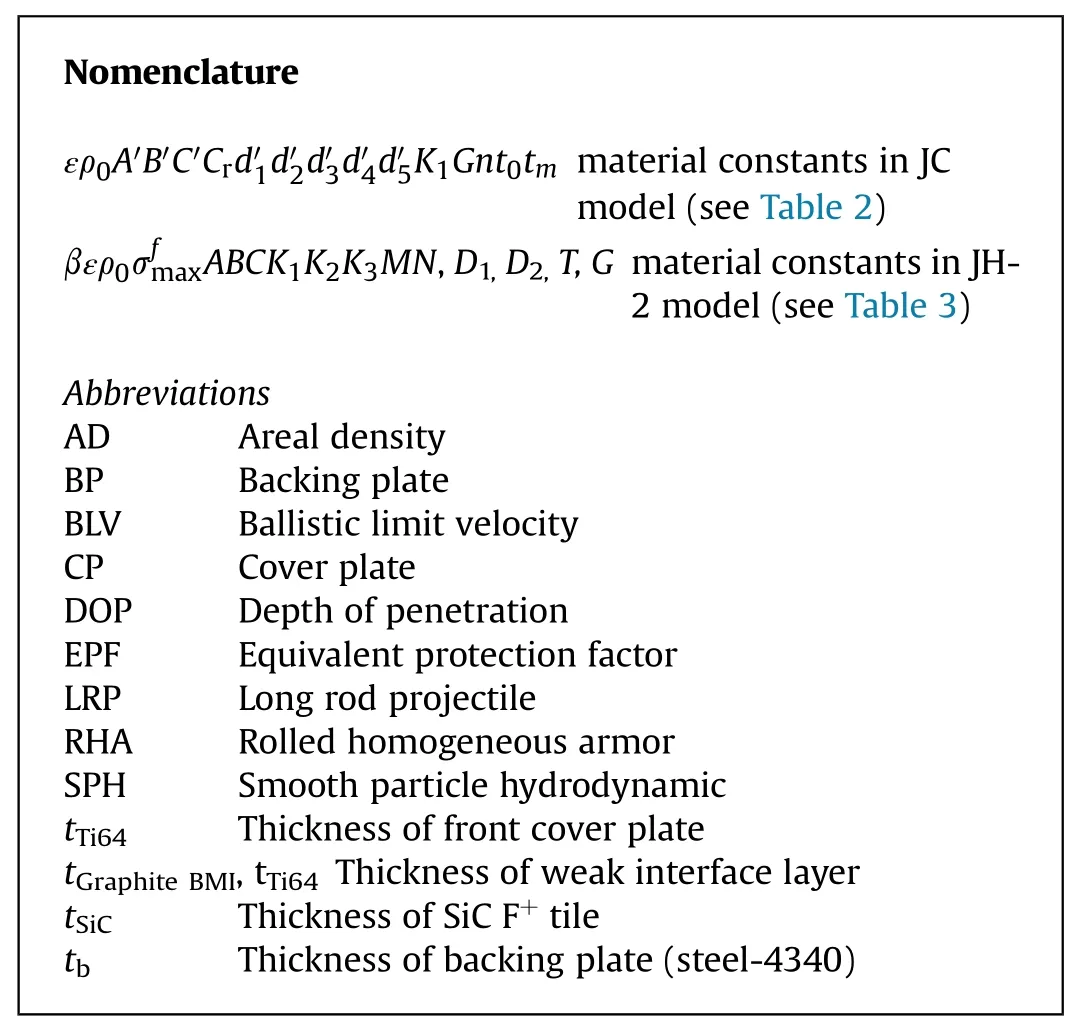
2.1.Experimental setup
The material used for the DOP dataset is a square SiC-Fceramic layer of 100 mm side length and 20 mm thickness embedded in square shape semi-in finite 4340 steel con finement of 125 mm side length whereas for bi-layer armor the thickness of both layers were changed.The ceramic-metallic layers were bonded using layer of epoxy adhesive Hysol.The adhesive layer plays a crucial role in multilayer armor performance and few researchers[12,13]concluded that a thin layer of adhesive is appropriate for advanced armor performance.During the fabrication process,a vacuum mixer(0.25-0.30 bar)was used for stirring the adhesive and spacers with thickness of 0.5 mm were used between the ceramic and metallic backing plate to maintain the adhesive layer thickness.Table 1 lists the technical details of materials used for ballistic testing.

Table 1 Mechanical properties of the component used in the ballistic firing experiments and simulations.

Table 2 The JC material model constants for tungsten alloy(W)[25,26],steel 4340[27],Ti-6Al-4V[28]and Graphite BMI[29,30].
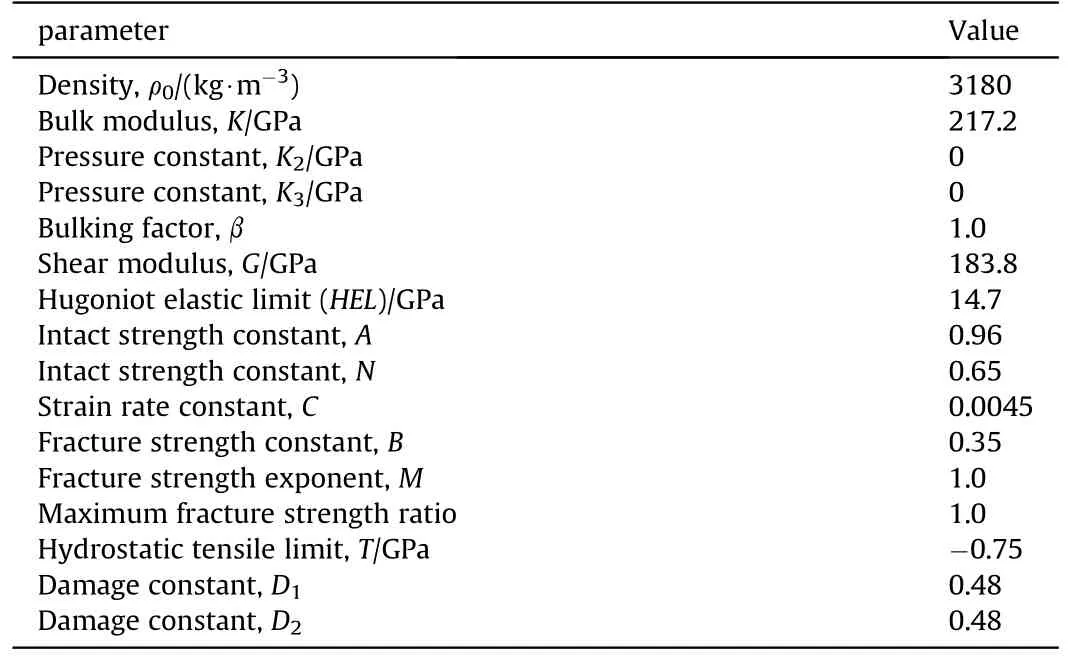
Table 3 JH-2 material and model constants for SiC 100[32-34].
A two stage light gas gun system was used to evaluate the ballistic performance of the bi-layer ceramic-metallic armor.In the first stage,the pressurized helium gas was used to propel the sabot guided LRP,shown in Fig.1.The impact velocity was controlled at the first stage using helium gas pressure.The setup comprises a high-speed digital camera SA-5 by Photron from Japan(150 KFPS with 256×144)to record the interaction of the LRP with the target.The experimental velocity of the LRP was captured with a laser speedometer system(VM600 by Symes from France).
In present study,projectiles made of tungsten alloy(W4Ni3Fe)having 96 g mass with L/D ratio of 13.86 were used and geometric details are shown in Fig.2.There were two parts to the experiments:(a)establishing depth of penetration(DOP)experimental data set for selected ceramic tile(SiC F)and(b)investigating the ballistic performance of the bi-layer ceramic armor with Ti-6Al-4V as cover plate and graphite as an interface weak layer.
The details of the LRP’s orientations are crucial at the point of the interaction with armor module.Therefore,a flash X-ray system(SCF 150 by Scandi flash from Sweden)was used to determine the pitch and yaw angles of the LRP,as shown in Fig.3.
2.2.Meshing details of numerical models
The three-dimensional numerical framework is developed using commercial AUTODYNhydrocodes for normal and NATO 60⁰impact.The LRP,front cover plate and weak interface layer are modelled using smooth particle hydrodynamic(SPH)processor with SPH size of 0.5 mm.While the SiC Fand backing plate(Steel-4340)is discretized using Lagrangian elements.The mesh sensitivity indicated that element size of 0.6 mm is suitable and good match to DOP dataset.For normal impact,within the central volume of 20 mm side,the mesh size is kept at 0.6 mm and is gradually increased beyond that.For oblique impact(half-domain),the mesh size is 0.65 mm for 20 mm in lateral,84 mm in longitudinal and 20 mm in vertical(i.e.through thickness).To combine multiple parts,joining technique was used and an erosion strain of 2 is used in the Lagrangian constitutive model for element deletion[9].The square tile SiC,having a side length of 100 mm and 20 mm thick,was embedded in a square shape steel 4340 con finement of 125 mm side length.The rear side of con finement is 10 mm thick as a backing plate(BP).Based on loading and geometrical symmetries,quarter and half-domain are discretized for normal and oblique impact problems respectively,as shown in Fig.4.
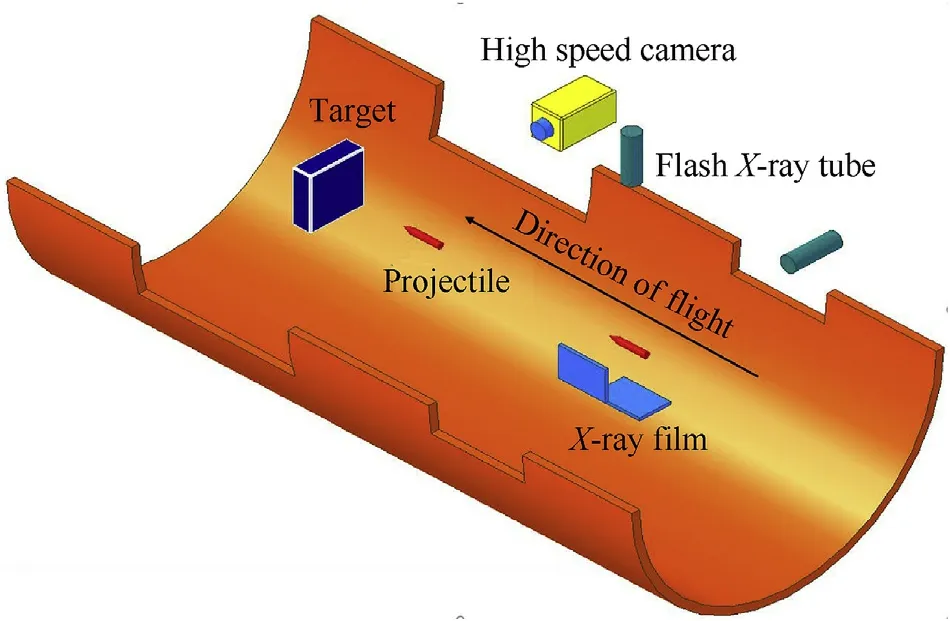
Fig.1.Basic layout of the experimental setup in the two-stage gas gun system.
2.3.Material models for numerical simulations
Phenomenological constitutive models of Johnson-Cook(JC)and Johnson-Holmquist(JH-2)are used to model the impact behavior of engineering alloys and ceramics,respectively.The recent literature[7,13,19-21]on the usage of these models justify their selection for the impact velocity range that is considered in this work.Recently,Deshpande-Evans[22]had proposed lattice plasticity and fracture mechanics based constitutive material model for the impact behavior of ceramics.However,the material constants to their model for SiC at the impact velocities of 800-1200 m/s are unknown.Therefore,the material parameters of the ceramic(as a front layer)and steel-4340(witness)are validated against the DOP experimental dataset and detailed information of the method can be found at[23,24].Johnson-Cook(JC)material model parameters of steel 4340 of 30 HRC,front cover and interface weak layers,and tungsten alloy are listed in Table 2.
The SiC is modelled with Johnson-Holmquist(JH-2)constitutive model,and its material parameters are listed in Table 3 with 0.94 GPa as tensile failure stress[31].
The numerical framework using the material parameters corroborated well with DOP dataset.Based on the LRP penetration in the witness block,the DOP is measured.For instance,at 1212 m/s and 1264 m/s,the LRP penetrated the steel 4340 witness block 49 mm and 51 mm,respectively,see Fig.5.The measured DOP is in good agreement(as shown in Fig.6)with the numerical simulations except at 1380 m/s(where the deviation is about~17%).One of the potential reasons for this divergence could be excessive loads on the LRP during the flight.It is reported[35]that when LRP travels at high velocity,it undergoes vibrational loads and bending stresses(unknown)reducing its penetration capability.However,in the numerical framework,these plausible environmental effects are not considered.Secondly,orientation(pitch and yaw)of conical tip of LRP during the experiments may also lead to decrease in penetration capability.
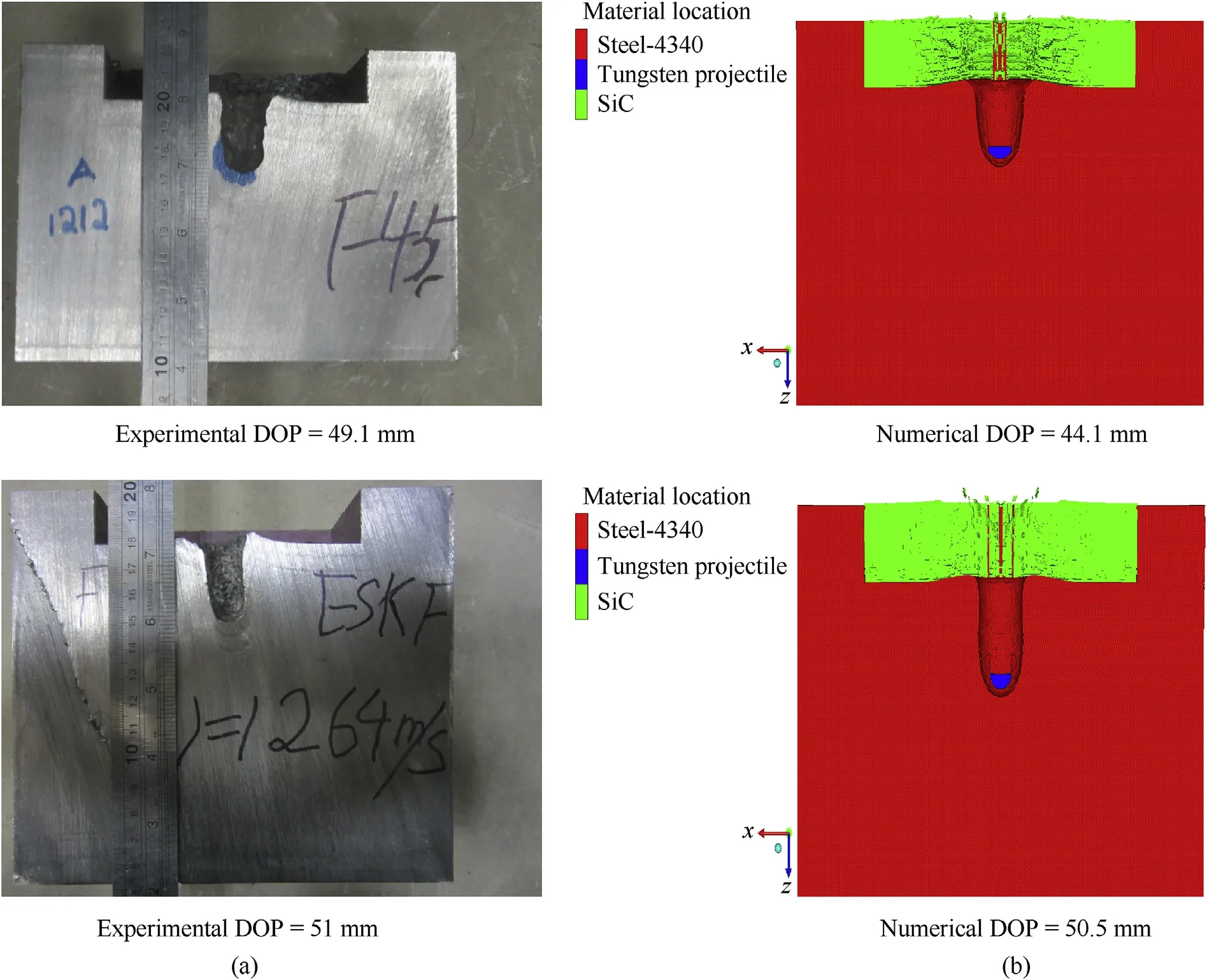
Fig.5.The comparison of the Depth of measurement technique in the SiC F+-Steel 4304 target against LRP made of tungsten alloys at impact velocity:(a)1212 m/s,and(b)1264 m/s.
Oblique impact(NATO 60):The penetration mechanism differs in normal and oblique(NATO 60)impact scenarios.Therefore,DOP dataset was used to calibrate model for normal impact condition.Upon satisfactory comparison between the measurements and simulated results,the calibrated numerical model was used for further parametric investigations.The con figuration of bi-layer armor is:t=20 mm,t=10 mm,t=2 mm(front cover plate),t=1 mm(interface weak layer).The LRP was inclined at 60obliquity towards the target,and reference impact point was at off distance(25 mm,15 mm)which was the actual setup in the experiments.In the case of oblique impact,mesh sensitivity was carried out by comparing the deformed armor geometry(especially the backing plate global deformation)against the experimental measurements.In both the experiments and simulations,the LRP is completely eroded in the ceramic tile and the asymmetric bulge was noticed at the rear face of BP.Due to asymmetric nature of penetration,the bulge also had axisymmetric geometry and making it dif ficult to measure accurately.However,the measured bulge on the backing plate from the experiment is 7.4 mm,and our simulation shows 7.2 mm.Fig.7 compares front view and isometric view of experimental measurements and simulations.
The effect of the interface layer was investigated for a new con figuration of bi-layer armor:t=20 mm,t=10 mm,t=2 mm(front cover plate),t=2.5 mm(interface weak layer).In this con figuration with 2.5 mmweak interface layer,the LRP is defeated at the surface of the backing plate and caused permanent plastic deformation(as shown in Fig.8).The measurement of the bulge is 3.8 mm in the experiment which matched closely with the simulation value of 3.943 mm.
Overall,the numerical simulations against the experiments for normal and oblique(NATO 60)matched well within the experimental scatter,the FE mesh selection,material constitutive parameters were deemed to be appropriate.

Fig.2.Schematic of the conical-nose projectile used in this study(all dimensions are in mm).
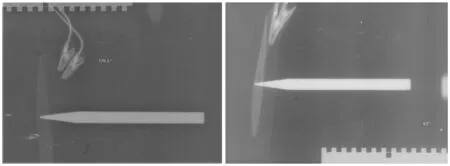
Fig.3.An example of X-ray image of long rod projectile right before impact on bi-layer ceramic armor.
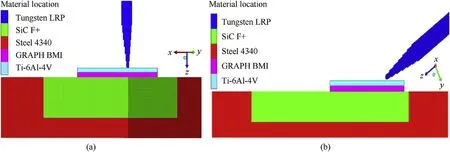
Fig.4.Schematic of SiC F+-steel armor with cover plate(a)quarter model for a normal impact(b)half model for oblique impact.
2.4.Effect of front cover and weak interface layer
In a previous investigation Ahmad et al.[9]reported that cover plate plays an important role in minimizing the in fluence of the initial shocks which can lead to premature failure of the ceramic module.Similar observations were reported by Hauver and coworkers[10]that inclusion of suitable support system such as cover plate and backing plate,radial support or pre-stressing the ceramic using shrink fit and other con finement methods.Anderson et al.[36,37]used copper as buffer before SiC ceramic to attenuate the shock impact of long gold rod projectile.Zhai et al.[40]performed extensive 2-D numerical using AUTODYNon the influence of front axial support to bare ceramic tile.The findings indicate that introduction of buffer layer to bare ceramic tile promotes dwelling-penetration transition phenomena,but it cannot just prolonged using thicker buffer layer.Moreover,buffer layer improves the dwell-to-penetration velocity when compared to armor without front protection.The inclusion of the cover and interface layer aids in offsetting the initial peak pressure on the ceramic tile under which it is highly suspected that it may suffer from disintegration due to shock loading re flection.Under the impact of high energy projectile,the ceramic being brittle in nature is prone to tensile cracking from the re flecting tensile waves from the free edges.The re flection of compressive wave front from the interfaces/boundary of the armor and the occurrence this event in ceramic can immediately lead to failure through rapid crack propagation and fragmentation.
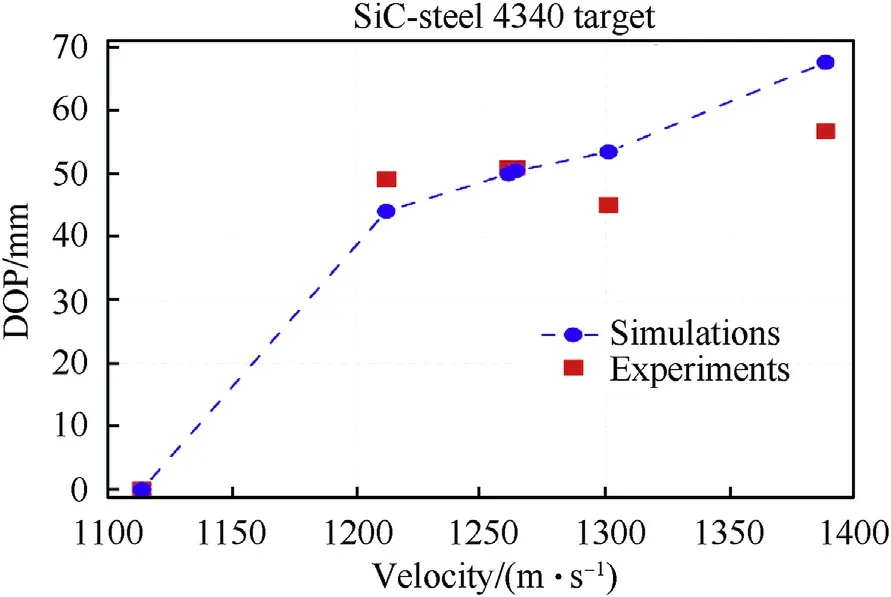
Fig.6.Comparison between 3D simulations and experimental DOP results on“SiC F+-steel 4340 target”under different impact velocities[9].
For instance,as presented in Fig.9 that,upon the LRP interaction with bare SiC tile,pressure distribution is localized with a high magnitude of 7.9 GPa.While in the latter case(t=2 mm,and t=2.5 mm)better pressure distribution with relatively low magnitude of 3.25 GPa is observed.Fig.10 shows the pressure pro file on the SiC Fsurface with and without front cover.The interaction of a shock with initiated cracks,ampli fication of the stresses around the impingement area,high-pressure discontinuity can further affect the ceramic compressive load capability.The addon ductility in ceramic armor in the form of front and back plates(either metals or long fiber reinforced polymer matrix composite laminates)will increase its performance by mitigating the local failure of the ceramic and also allowing global structural deformation[39].
The in fluence of axial support can also be seen with LRP positions at different time interval as displayed in Fig.11.For instance,at 60μs,the LRP is dwelling on SiC surface whereas it has begun to penetrate (approximate DOP 12.253 mm) in no-buffer con figuration.
The erosion fragments produced during penetration through front con finement accumulated at the interface,whereas for a bare ceramic damaged fragment parts were expelled from the area of impact,showing major fracture around the penetration,indication lower ballistic performance compared to con fined front face ceramic.It is also realized that inclusion of front Ti-6Al-4V cover plate and compliant or weak interface layer graphite minimizes the stresses around the impingement area and aid in removing the conical tip of LRP before it reaches to the SiC surface.The weak interface layer helps in directing the lateral flow of the eroded products and strengthen the target.Titanium alloy cover plate and graphite interface weak layer laterally spread the impact shock away from the SiC tile and reduces the ampli fication of the stress accumulation at the front surface of the SiC tile.The dwelling time increases before it penetrates into ceramic armor.Hence,it is safe to conclude that con finement or axial support in the ceramic armor design enhances the ballistic performance via offsetting the initial high shock loading,restraining outward movement of crushed ceramic and decreasing the stress concentration around the impingement area of LRP.
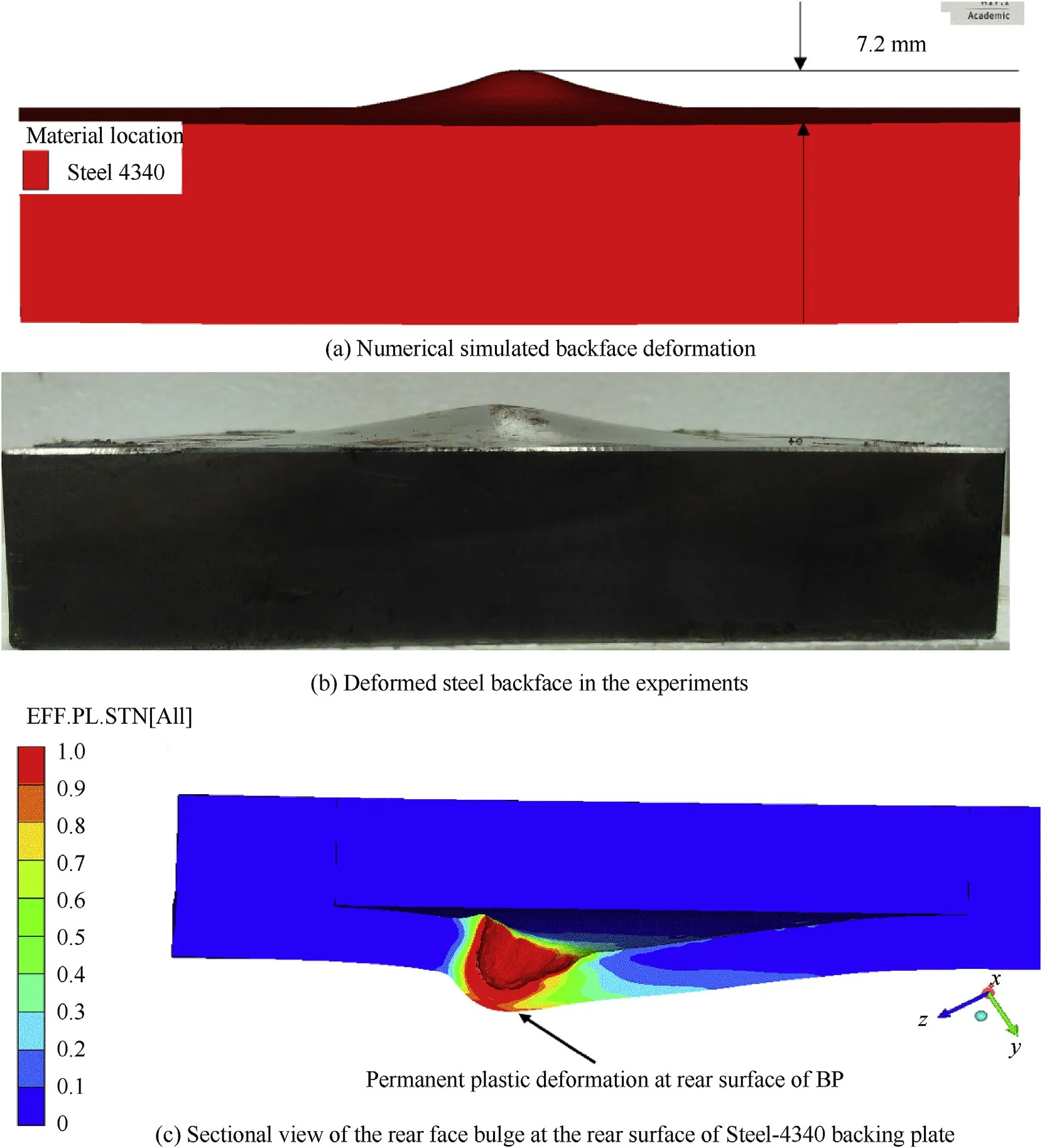
Fig.7.Comparison of experimental and numerical result for t Ti64=2 mm(front cover plate),t Ti64=1 mm(interface weak layer)at 1196 m/s:(a)Numerical result,(b)Condition of backing plate after impact,and(c)Contour plot of effective plastic strain for steel-4340 backing plate.
2.5.Equivalent protection factor(EPF)
Equivalent protection factor,de fined as the ratio of thickness required against oblique impact to the thickness required for normal impact for similar protection,is a measure to assess the performance of armor under oblique impact.The EPF for monolithic armor(ignoring the material speci fic strength and stiffness)can be calculated as follows:
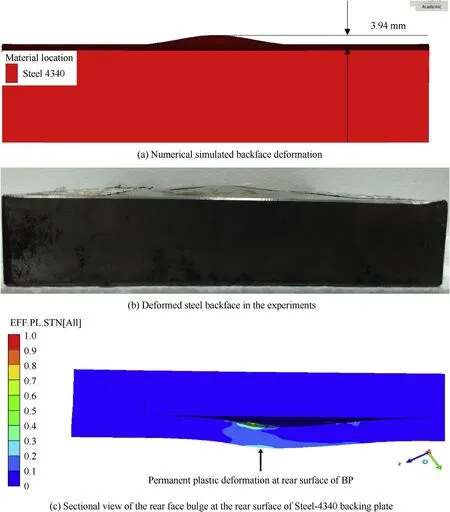
Fig.8.Comparison of experimental and numerical result for tTi64=2 mm(front cover plate),tGraphite BMI=2.5 mm(interface weak layer)at 1220 m/s:(a)Numerical result,(b)Condition of backing plate after impact,and(c)Contour plot of effective plastic strain for steel-4340 backing plate.

Fig.9.Illustration of the initial pressure rise and distribution upon interaction of LRP with SiC F+EKasic®:(a)No cover and interface layer and(b)t Ti64=2 mm,and t GraphiteBMI=2.5 mm.

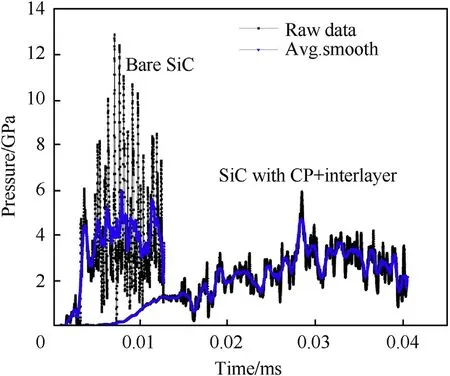
Fig.10.Comparison of pressure pro file of SiC F+EKasic®:under NATO 60⁰LRP impact at 1220 m/s.
where,tthe thickness of plate to defeat normal attack,tthe thickness of plate,i.e.the inclined atθdegrees to vertical to defeat the attack.For monolithic armorθis found to be smaller than tas plate inclination increases the amount of materials in the path of penetration and secondly,the obstruction in the projectile path through asymmetric forces around it,causing the projectile to take a less energetically ef f icient path through the plate.
For the bi-layer ceramics considered in this study,the EPF(see Fig.12)can be calculated through the areal density of the armor module required for normal and oblique impact scenario for similar protection,as follows:
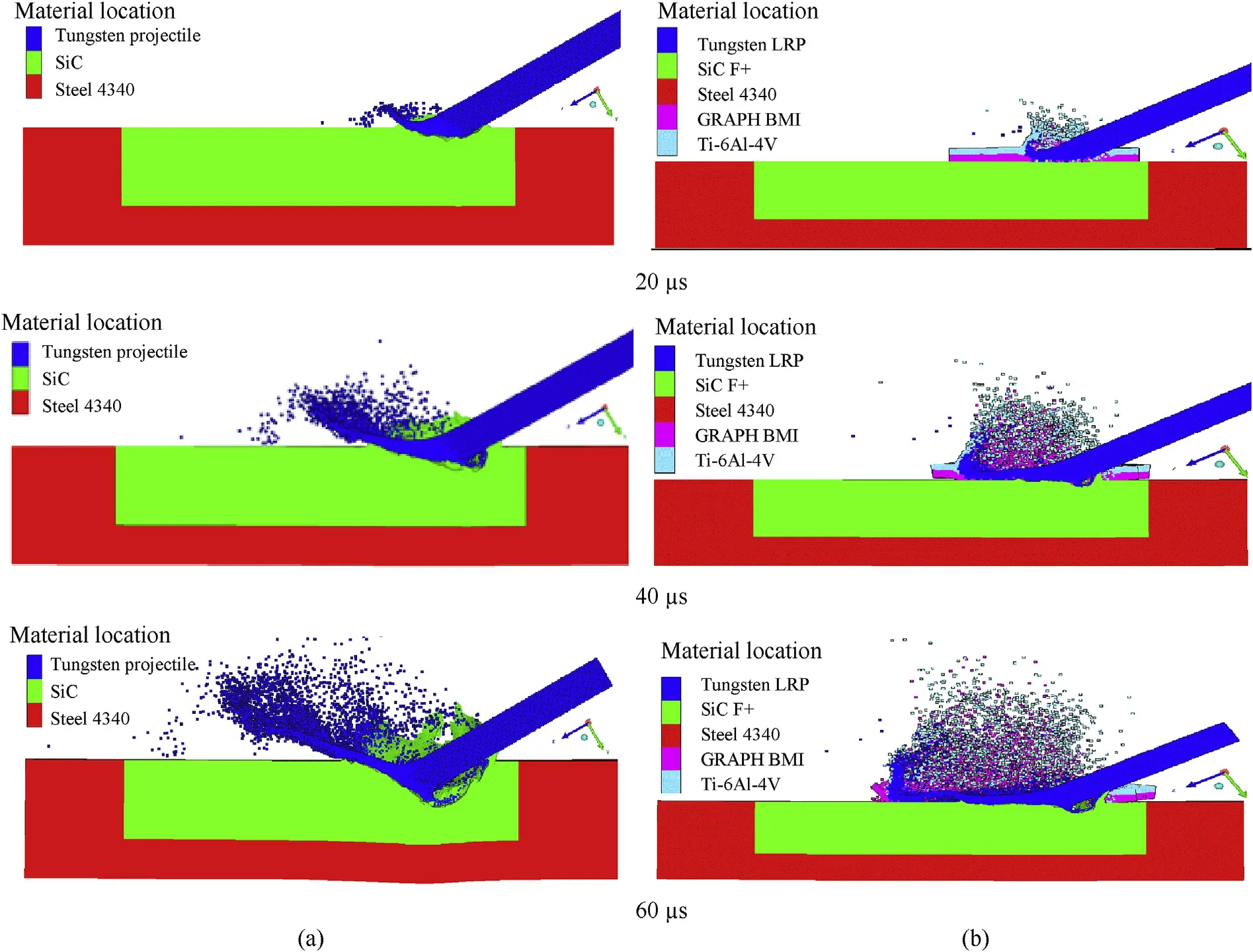
Fig.11.Projectile penetration at different times for oblique impact of LRP of 1220 m/s initial velocity onto armor of fixed SiC tile thickness,t SiC=20 mm,BP thickness,t b=10 mm,(a)without cover and interlayer,and(b)with t Ti64=2 mm,and t Graphite BMI=2.5 mm.
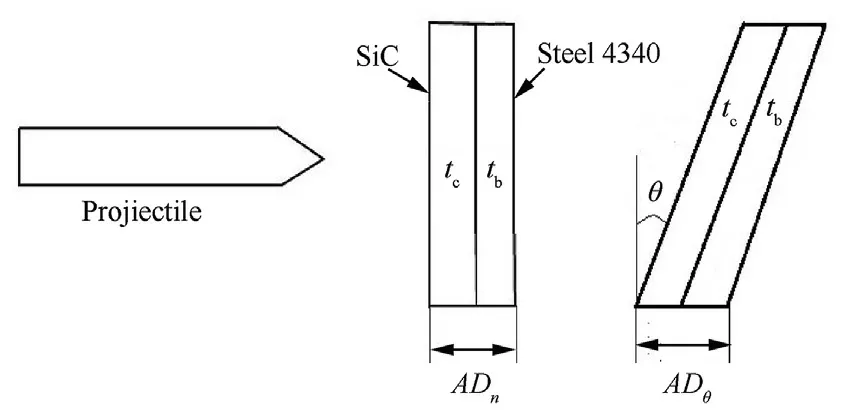
Fig.12.Two targets areal densities AD n and ADӨrespectively for the same level of protection.Calculation of equivalent protection factor(EPF):EPF is calculated according to the following procedure.

where,AD=tρ+tρis the areal density of bi-layer armor under normal impact and ADθ=tρ+tρis the areal density of inclined bi-layer armor,ρandρare the densities of ceramic and backing plate materials,respectively.Hetherington and co-workers(see Refs.[3,4])developed a model assuming that under oblique impact the projectile tip deforms into an ellipse as it impacts the front face of the ceramic and empirically shown that the arealdensities for normal and oblique impact are related for a given ballistic(note that it is different from the areal or thickness relationship)velocity as a cosine function of obliquity,as

(a)Initially,the ballistic limit velocity is determined for bi-layer armor con figuration under normal impact for various SiC tile thicknesses.
(b)Secondly,for the same BLV through simulations,an optimized armor overall thickness is determined for oblique impact(NATO 60)by varying both the SiC and steel layer thicknesses(so,it involved a number of simulations)
(c)Finally,the ratio between their areal densities is calculated and presented as an equivalent protection factor.
Earlier in the detailed numerical investigation of bi-layer armor under normal impact scenario,Chi et al.[40]found that in the bilayer ceramic-metallic armor con figuration,the front ceramic layer should be 55%-60%of total thickness of the whole armor to have best ballistic performance.Moreover,Ahmad et al.[41]conducted a series of ballistic experiments on the alumina-steel armors against small caliber projectile under normal impact scenario.The study suggested that in the bi-layer con figuration under normal impact scenario,the best ballistic performance can be achieved when the ratio of the hard front layer is in between 0.55 and 0.62 concerning the overall thickness of bi-layer armor.Similarly,it is also stated that in the armor design hard ceramic faced should contain 60%of system mass[42].The subsequent section will present comparison ballistic performance of bi-layer armor con figuring the front cover plate and interface weak layer under the normal and oblique impact scenarios.
2.6.Comparison of normal and oblique impact
This section describes the effect of obliquity(NATO 60)on the ballistic performance of bi-layer armor and presents a comprehensive comparison between normal and oblique impact.Under normal impact condition,the imparted kinetic energy is highly localized as the contact area is small and the stresses are high in amplitude.The obliquity is usually de fined as an angle between normal to impact surface and the velocity vector of the projectile.Hauver co-workers[10]conducted interface defeat experiments under the impact scenario from normal to 45-60and reported reduced micro-damage formation on the ceramic armor under oblique scenarios resulting in improved ballistic performance.Under the oblique impact scenario,reduction in the normal component of impact velocity and increment in the projectile and target surface area leads to improved protection capability.
The current research work assesses the ballistic performance of the bi-layer armor through determining the ballistic limit velocity(BLV)for each armor con figuration.It is stated that the experimental ballistic limit velocity(V)[43]is the velocity at which there is a 50%probability of armor penetration.However,in simulation the defeat of the LRP at the surface of the backing plate(steel 4340 in the current study)is considered as BLV for armor con figuration,see Appendix A.1 for a more detailed explanation.The subsequent sections will investigate the in fluence of the geometric parameter(thickness variation of SiC and steel 4340 separately)of the bi-layer on their ballistic performance.The BLV,under normal impact scenario,will be determined for various bi-layer armor geometry.Later,for similar protection level(i.e.same BLV),the bi-layer armor con figuration will be determined using a series of simulations.
The geometric details of the bi-layer armor are as follows:SiC tile thickness,t= 20 mm,BP thickness,t=10 mm,and t=2 mm(front cover plate),t=2.5 mm(interface weak layer).The normal incident impact causes severe damage to the target because the damage initiation and accumulations remain locally in the target.Secondly,the exertion of the energy carried by the LRP in small contact area makes it more lethal.The BLV was found from a series of simulations to be 855 m/s.At this impact velocity,the BP deforms into a conical dish on the outer surface without the penetration of the projectile,as shown in Fig.13.For similar armor con figuration,the experiment is carried,and at 847.5 m/s impact velocity,the LRP is defeated at the surface of the backing plate with a conical bulge on the rear surface,see Fig.15.Now,the carried numerical investigation is af firmed using testing;an oblique scenario will be modelled for similar protection.
The impact flash is a release of the high energy as a consequences of ionization of tungsten materials[44].Fig.14 presents the stages of the LRP interaction on the armor module and generated impact flash indicates the erosion projectile.It can be seen that almost half of the LRP along with its conical tip is eroded on the SiC Fsurface from 14μs to 18μs.
It is observed that inclining the armor module decreases the requirement of material to vindicate the damage caused by the LRP.The deformation is found to be global and higher degree of damage is noticed in the lateral direction of the armor.The damage in SiC tile progresses the lateral direction(toward to the con finement)with the LRP penetration.In the oblique impact(NATO 60)scenario,the LRP interacts with more materials which change its penetration path from axial to the lateral direction(towards con finement).The LRP is subjected to asymmetric forces,thereby de flecting its penetration direction.Further,the armor obliquity gives higher penetration area to resist.The geometric thickness of the oblique target was estimated for the BLV of the normal impact.At 855 m/s,the numerically determined armor con figuration for equivalent protection under NATO 60impact is:SiC tile thickness,t=13.1 mm,BP thickness,t=6.55 mm,and t=2 mm(front cover plate),t=2.5 mm(interface weak layer).Fig.16 shows the top and side view of the deformed armor module under NATO 60impact.
The numerical simulation predicted the SiC tile and backing plate to be 13.1 mm and 6.55 mm thick,respectively,for an equivalent BLV of 855 m/s.It was very expensive and dif ficult task to achieve such precise thicknesses for the experimental validation.Therefore,a 14 mm SiC tile and 7 mm backing plate thick were chosen.The final armor con figuration(see Fig.18)for NATO 60impact as SiC tile thickness,t=14 mm,BP thickness,t=7 mm,and t=2 mm,t=2.5 mm interlayer is tested and impact velocity of LRP is recorded to be 860 m/s.Fig.17 illustrates the LRP penetration transition on the SiC tile surface in the form of impact flash.In the post-impact analysis,the recovered LRP weight was 8.72 g(which is less than 10%of original weight,96 g)and there was 2.95 mm deep indentation into the witness block.The length of residual LRP could not be measured due to asymmetric geometry.Based on DOP in the witness block and weight of the remnant of LRP,it was concluded that the impact velocity 860 m/s is close to the predicted numerical BLV of the ceramic armor module.
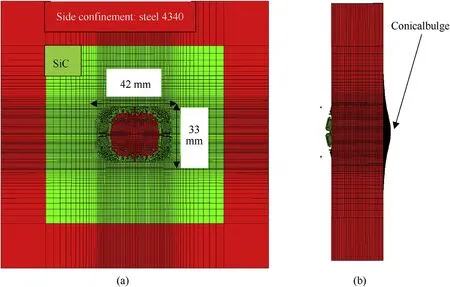
Fig.13.Simulation results of armor con figuration under normal impact of LRP at 855 m/s:SiC tile thickness,t SiC=20 mm,BP thickness,t b=10 mm,and t Ti64=2 mm,t GraphiteBMI=2.5 mm interlayer weak layer(a)front view,(b)side view.

Fig.14.Normal impact experiments captured by high-speed camera.
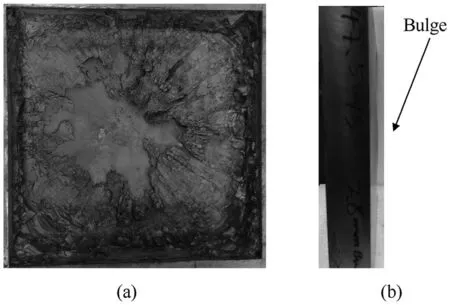
Fig.15.Ballistic limit velocity 847.5 m/s LRP:SiC tile thickness,t SiC=20 mm,BP thickness,t b=10 mm,and t Ti64=2 mm,t Graphite BMI=2.5 mm interlayer weak layer,(a)front view,(b)side view.
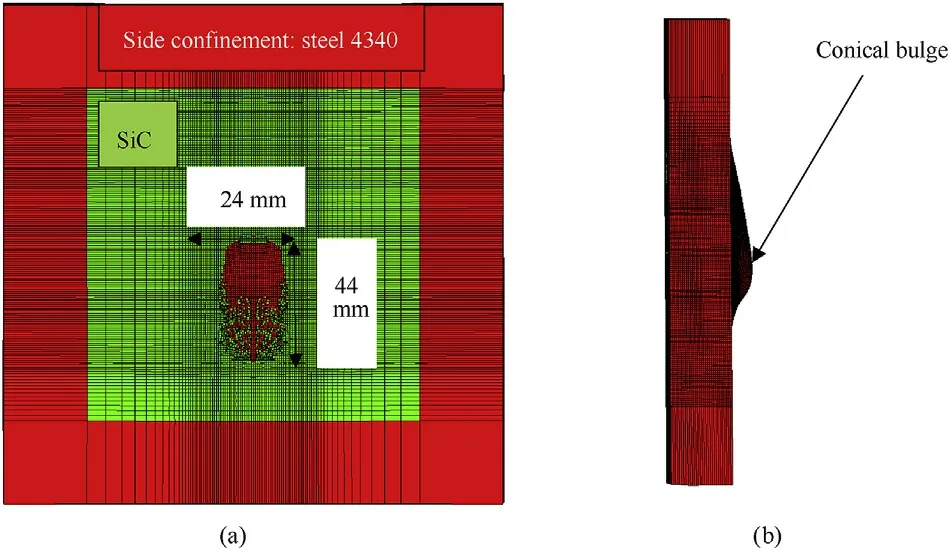
Fig.16.Simulation of oblique impact of LRP at 855 m/s:SiC tile thickness,t SiC=13.1 mm,BP thickness,t b=6.55 mm,and t Ti64=2 mm,t Graphite BMI=2.5 mm interlayer weak layer(a)front view,and(b)side view.
2.7.Parametric study of bi-layer armor con figurations
Upon validation of the bi-layer armor BLV through experimental measurements,a series of simulations were carried out to investigate the in fluence of the SiC tile and metal backing support on the protection.The following section will present results of the varied SiC tile thickness and backing plate thickness in bi-layer armor design.A detailed explanation of measuring the BLV is given in Appendix.

Fig.17.Oblique impact experiments captured by high-speed camera.
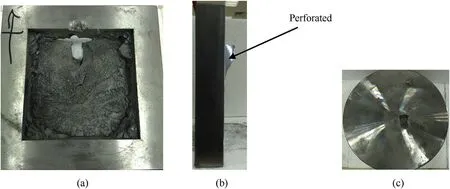
Fig.18.Oblique impact experiment velocity 860 m/s LRP:SiC tile thickness,t SiC=14 mm,BP thickness,t b=7 mm,and t Ti64=2 mm,t Graphite BMI=2.5 mm,(a)front view of module con figuration,(b)perforated BP and(c)formed cavity in the witness block made of steel-4340.
2.7.1.SiC tile thickness variation
Initially,the in f luence of SiC tile thickness on ballistic performance is explored numerically by keeping the backing plate thickness to 10 mm and all other dimensions being the same.Table 4 lists the armor con figurations used in the numerical investigations.For normal impact,the SiC tile thickness is varied,and their BLV is determined.Similarly,BLV for a series of armor configurations(which are slightly different from the normal impact ones)under oblique impact(NATO 60)is calculated.

Table 4 Armor con figuration details for various SiC tile thickness.
The variation of areal density with BLV for normal and NATO 60is shown in Fig.19:it reveals that inclining the armor reduces weight penalty with increasing ballistic limit velocity.For instance,at an impact velocity of 1014 m/s,the areal density of armor to defeat LRP is 124.78 kg/m(NATO 60)while under normal impact it is 186 kg/m(at BLV 1008 m/s)giving a weight saving of 33%.For 855 m/s to 1336 m/s,under normal impact the required ADto defeat LRP increases from 155 kg/mto 225 kg/m(~31%)whereas under oblique impact the requirement ADθis 116 kg/mto 161 kg/m(~28%),approximately.
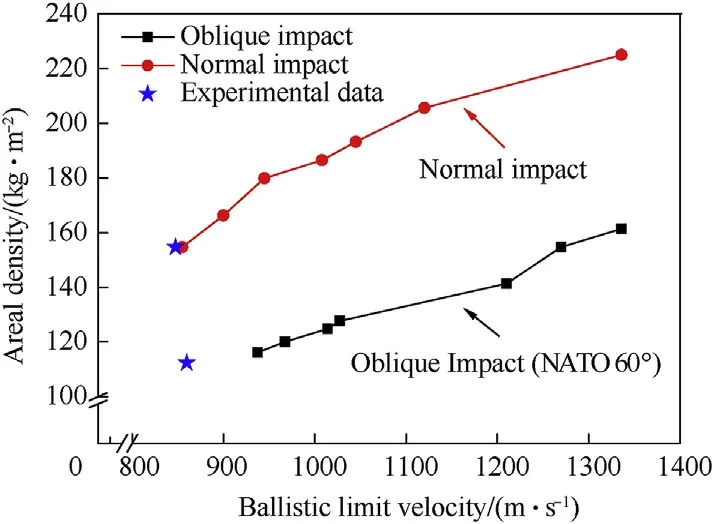
Fig.19.Variation of areal density with the ballistic limit for normal and NATO 60°impact conditions for fixed backing plate thickness.
2.7.2.Backing plate thickness variation
Now consider the effect of varying backing plate thickness on BLV for a fixed 20 mm thick SiC ceramic.Increasing backing plate thickness certainly improves the ballistic performance of armor as it enhances the flexural stiffness apart from increasing the armor weight(see Fig.20).The armor con figurations and their corresponding BLVs and areal densities are shown in Table 5.It shows that for BLV increment from 890 m/s to 1090 m/s,the requirement of the total AD under normal impact scenario ranges from 170 kg/mto 238 kg/m(~28%).Whereas for NATO 60impact,AD increases from 102 kg/mto 124 kg/m(~18%)for similar BLV range.
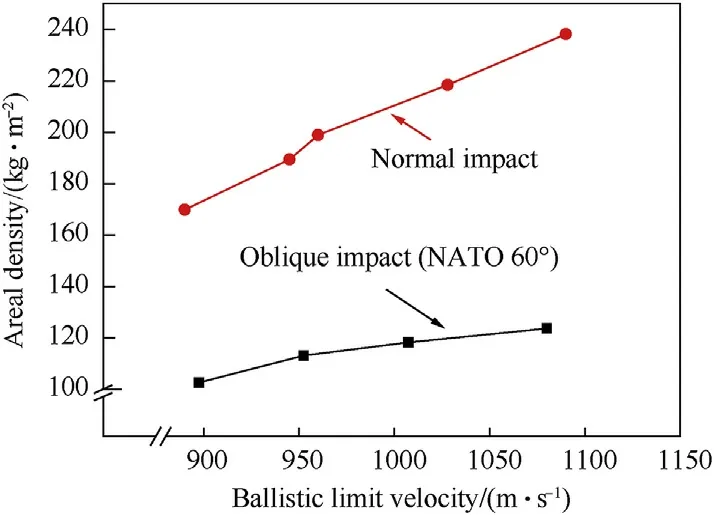
Fig.20.Variation of the areal density with the ballistic limit for normal and NATO 60°impact conditions for fixed SiC F+tile thickness.
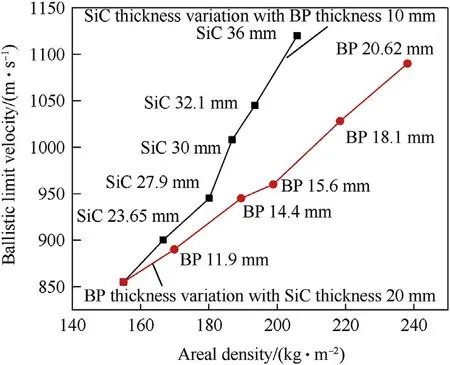
Fig.21.Comparison of areal density for SiC F+tile thickness and BP thickness.
3.Discussion
The present investigation evaluated the performance of the bilayer ceramic module under normal and NATO 60impact scenarios and also explored the in fluence of axial support on the ballistic performance.Thorough investigation via using validated numerical model indicated that increasing SiC tile thickness improves BLV of the armor module with less increment in areal density than increasing backing plate(metallic).Despite having excellent compressive properties ceramic suffers due to lower toughness which is improved by having metallic backing plate(i.e.Steel-4340 in our case study).It helps in distributing the load over a wider area through its bending and stretching mechanisms.The ballistic performance of an armor improves under the oblique impact scenario due following primarily reasons:(a)reduction in the normal component of impact velocity,(b)increased through thickness of armor,and(c)deviation in the penetration path of projectile due to developed asymmetric forces(as shown in Fig.A5).However,the failure mechanism differs in the metal backing support which adds toughness to the target.Fig.21 presents the comparison of selected areal densities required to defeat LRP under normal impact scenario.It is evident that for a given areal density,increasing the SiC layer thickness provides higher BLV than increasing the backing plate thickness.
Therefore,to estimate EPF,experimental and numerical results from section 2.7.1 for SiC tile variations are selected.The current research work aimed to determine the ratio of ceramic-metallic bilayer armor under NATO 60impact of long rod projectile.The initial areal density under normal impact(see Table 6)and later that armor con figuration has been optimized for the similar level(for the same impact velocity)of protection.For instance,at 900 m/s BLV,the areal density for oblique impact(NATO 60)is found to be 107.95 kg/mwhereas for normal impact it is 166.6 kg/m.It implies that inclination of armor can reduce weight by 35.20%and improves the ballistic performance of armor under obliquity.A similar trend is observed at the higher impact velocities and their detailed values of areal densities are listed in Table 6.In the current research study,after a series of the numerical investigation of NATO 60impact,the EPF is found to be 0.68 approximately.
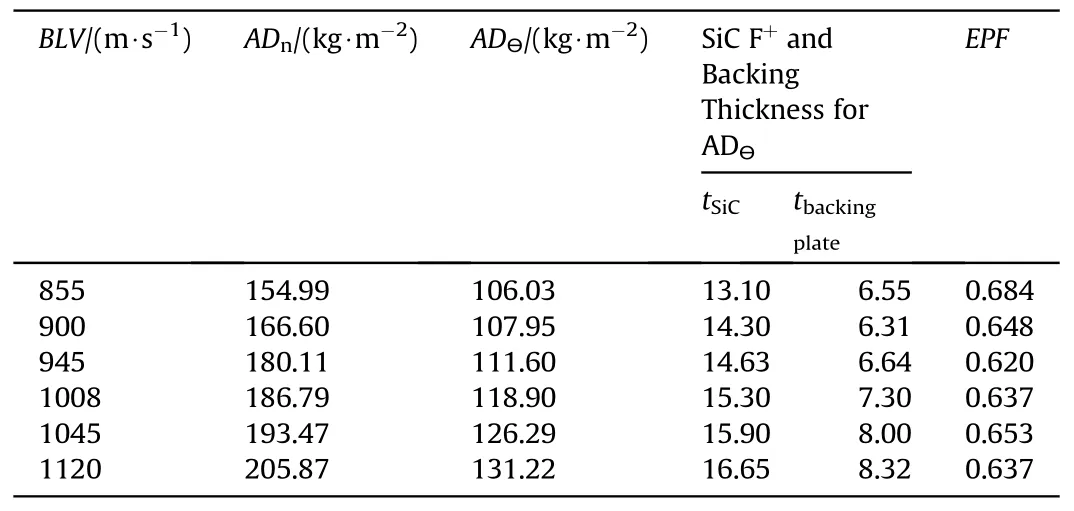
Table 6 Optimized armor con figuration for oblique impact.
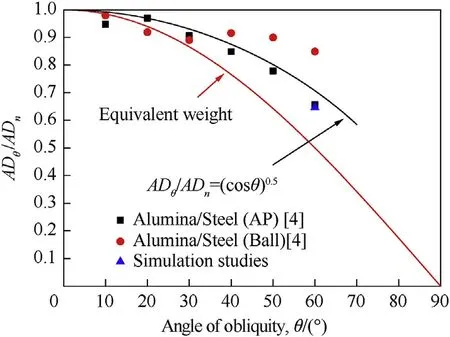
Fig.22.Determination of equivalent protection factor for bi-layer armor[4].

Table 5 Armor con figuration details for various backing plate thickness.
EPF values listed in Table 6 are plotted in Fig.22 and are compared with the empirical model of Hetherington et al.[4].(based on equation(3)):simulation values differ by 5%from the empirical values.This EPF value gives the amount of weight saving,i.e.31%achieved when we incline the armor from normal to oblique to attain the same BLV of 855 m/s for NATO 60.This same procedure is carried out to calculate the EPF at different BLVs.
The simulation results are in close agreement with experimental results conducted for armor piercing projectile by Hetherington et al.[4],as shown in Fig.22.It is to be mentioned that the current analysis is carried for conical tip LRP against SiC F-Steel 4340 armor con figuring t=2 mm,and t=2.5 mm front axial layers.The difference in the optimum EPF may be attributed to the change in LRP projectile.
4.Conclusion
In this work,the ballistic performance of bi-layer ceramic-steel armor module with 2 mm thick titanium alloy and 2.5 mm thick graphite was assessed numerically and supported with a limited expensive two-stage gas gun firing experiments.The validation of the material parameters used in the model was conducted using the depth of penetration tests of SiC with steel backing.The in fluence of geometrical parameter(thickness)of SiC tile and 4340 steel backing plate were explored numerically using AUTODYN,and the key findings are as follows:
·Having a cover plate and compliant interlayer in SiC-steel armor increasing the ballistic performance by increasing the interface dwell and decreasing the peak pressure on the ceramic.
·For a given ballistic limit and angle of impact,the numerical simulations indicate that the increasing the ceramic layer thickness decreases the areal density,when the initial thickness of the BP is greater than or equal to 10 mm considered in this study(Fig.21).

Govind and Goh have conducted the experiments.Shi carried out the numerical simulations.Sridhar had secured the funding and overall supervised the work.The initial draft was written by Govind with inputs from Goh and Shi.It was vetted and corrected by SI.
The raw/processed data required to reproduce these findings cannot be shared at this time due to technical or time limitations and it will be made available via web-link.
The authors declare that they have no known competing financial interests or personal relationships that could have appeared to in fluence the work reported in this paper.
Authors thanks Temasek Laboratories@Nanyang Technological University(TL@NTU)for the financial support through the project number TL9013103084-02.Authors thank Dr.Yuan Jianming for experimental help and Mr Anirudh Mohan Kumar,Mr Anoop Savant for the computational assistance.GG thanks Dr Karthik Ram Ramakrishnan of Marie Curie Research Fellow at the University of Bristol for useful suggestions.
A.1 Methodology to determine the ballistic limit velocity
Fig.A 1 elucidates the procedure of selecting ballistic limit velocity(BLV)for given bi-layer armor con figuration.The performance of the given armor geometry has been investigated at different impact velocities through commercial code AUTODYN®.For instance,the con figuration with following details:SiC tile thickness,t=30 mm,BP thickness,t=10 mm,and t=2 mm front cover layer,t=2.5 mm interlayer,is tested numerically at three different impact velocities starting from 1003,1008 m/s and 1020 m/s.It is evident from the numerical result that LRP,travelling at 1003 m/s,lost all its energy in the middle of SiC tile and stopped whereas,at 1008 m/s,it has reached to the rear surface of the backing support(made of steel 4340)and coming to rest.As the impact velocity is increased from 1008 m/s to 1020 m/s,the given armor is not able to sustain the damage and allowing LRP to penetrate armor completely.These observations enabled in selecting the BLV for aforementioned armor design is 1008 m/s at which the LRP is defeated at the rear surface of the BP.
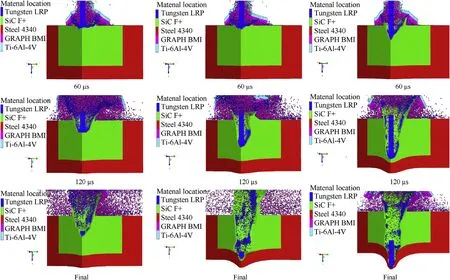
Fig.A 1.The position of LRP during the penetration under normal impact for different ballistic limit velocity:SiC tile thickness,t SiC=30 mm,BP thickness,t b=10 mm,and t Ti64=2 mm,and t Graphite BMI=2.5 mm.
A similar methodology is used to determine the con figuration for oblique scenarios.Fig.A 2 presents the oblique impact(NATO 60)of bi-layer scenarios.The oblique impact con figuration is determined for the close range of the BLV of the normal impact of LRP.
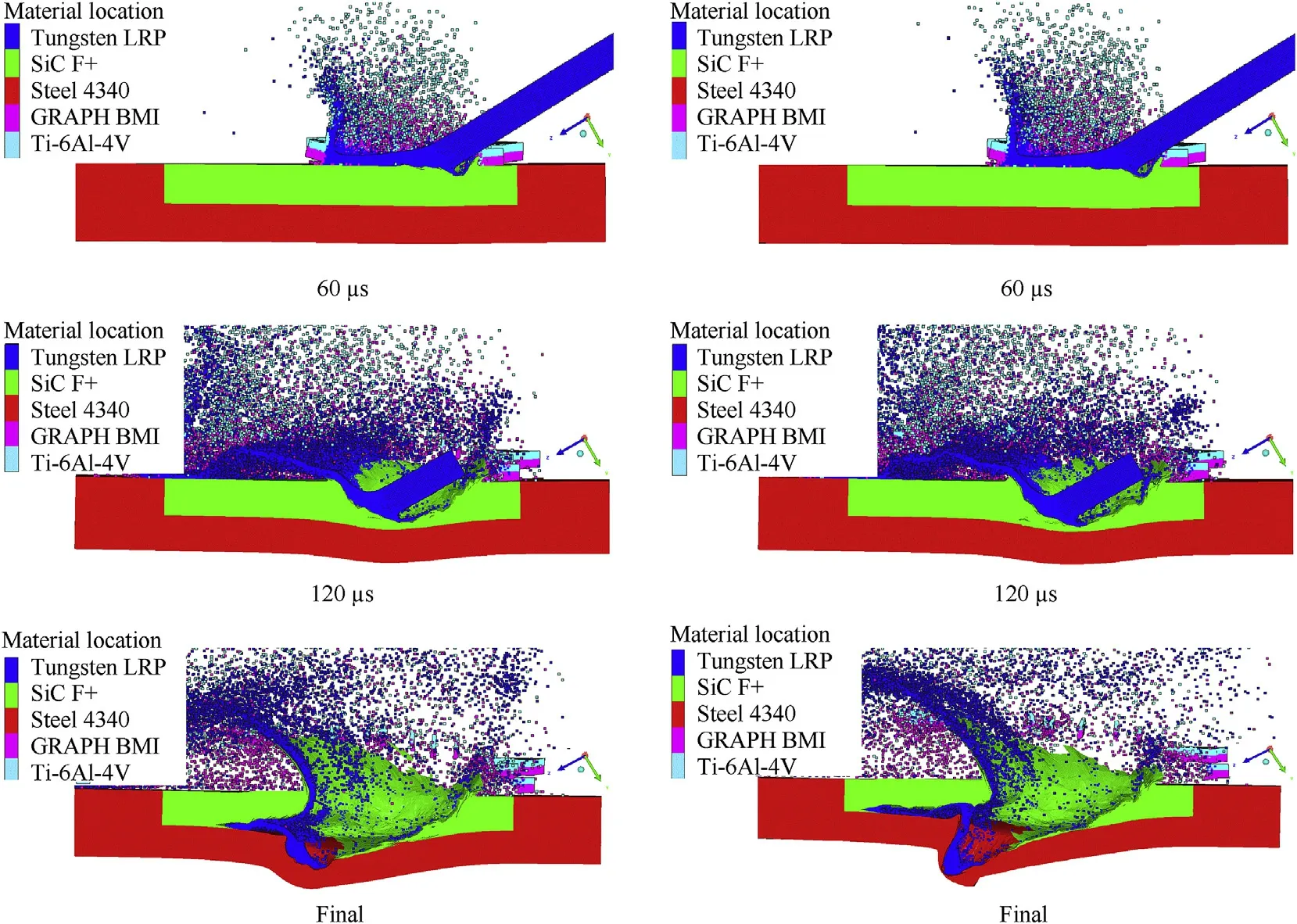
Fig.A 2.The position of LRP during the penetration under normal impact for different ballistic limit velocity:SiC tile thickness,t SiC=10.5 mm,BP thickness,t b=10 mm,and t Ti64=2 mm,and t Graphite BMI=2.5 mm.
A.2 Comparison of bi-layer armor module with and without a cover plate
Ceramic,being brittle in nature,can sustain larger compressive stresses than the tensile stress.In the high velocity impact scenario,the imparted compressive wave travels to the boundary of the system and re flect as a tensile wave under which ceramic is prone to spalling.Hence,to achieve the better ballistic performance of the armor module,Hauver co-workers[10]had suggested the inclusion of suitable support system such as cover plate and backing plate,radial support or pre-stressing the ceramic using shrink fit and other con finement methods.Furthermore,Anderson et al.[38]carried out experimental studies on the cover plate(copper in their studies)effect on the cylindrical SiC ceramic against long gold rod projectile.The experimental results indicated that cover plates assist in improving the ballistic performance of the armor via increasing the dwell time of the LRP.Similar observations were indicated in the interface defeat experiments where a copper buffer was used to attenuate the impact shock and to improve the dwellto-penetration velocity compare to armor without front protection[36].The cover plate plays a major role in mitigating the initial shock waves,and it was indicated by Ahmad et al.[9]where a multilayer armor module was prepared to achieve interface defeat.It conFig.d three cover layers and successfully aided in achieving interface defeat.
Under the impact of high energy projectile,the ceramic being brittle in nature prone to tensile cracking from the re flecting tensile waves from the free edges.The re flection of compressive wave front usually occurs from the interfaces/boundary of the armor and the occurrence this event in ceramic can immediately lead to failure(through rapid crack propagation and fragmentation).The interaction of a shock with initiated cracks,ampli fication of the stresses around the impingement area,high-pressure discontinuity can further affect the ceramic compressive load capability.The add-on ductility in ceramic armor in the form of front and back plates(either metals or long fiber reinforced composite)laminates will increase its performance by mitigating the local failure of the ceramic and also allowing global structural deformation[39].The inclusion of the cover and interface layer aids in offsetting the initial peak pressure on the ceramic tile under which it is highly suspected that it may suffer from disintegration due to shock loading re flection.As presented in Fig.A 3 that,upon the LRP interaction with SiC tile,pressure distribution is localized and magnitude of the developed stresses is 6.7 GPa while in the latter case(t=2 mm,and t=1 mm)better pressure distribution and relatively low magnitude of stress 2.9 GPa is observed.

Fig.A 3.Illustrates the initial pressure rise and distribution upon interaction of LRP with SiC tile:(a)No cover and interface layer and(b)t Ti64=2 mm(front cover plate),t Ti64=1 mm(interface weak layer)at 1196 m/s.
The following describes the effect of cover plates on the bi-layer ceramic armor under NATO 60impact condition.The armor consists of the following:(a)SiC t=20 mm,BP thickness,t=10 mm,(b)t=20 mm,BP thickness,t=10 mm and t=2 mm(front cover layer),t=1 mm(interface weak layer).The key observations are presented with LRP penetration position with time.It is evident in Fig.A4 that residual length is smaller for interlayer con figuration and results in less damage to armor module.At 60μs the LRP is dwelling on SiC surface whereas it has begun to penetrate(approximate DOP 11.10 mm)in no-buffer con figuration.The inclusion of thin cover plate aids in reducing the peak stresses on the SiC tile and spreading the load bearing area.It minimizes the outward flow of ceramic upon interaction of LRP.
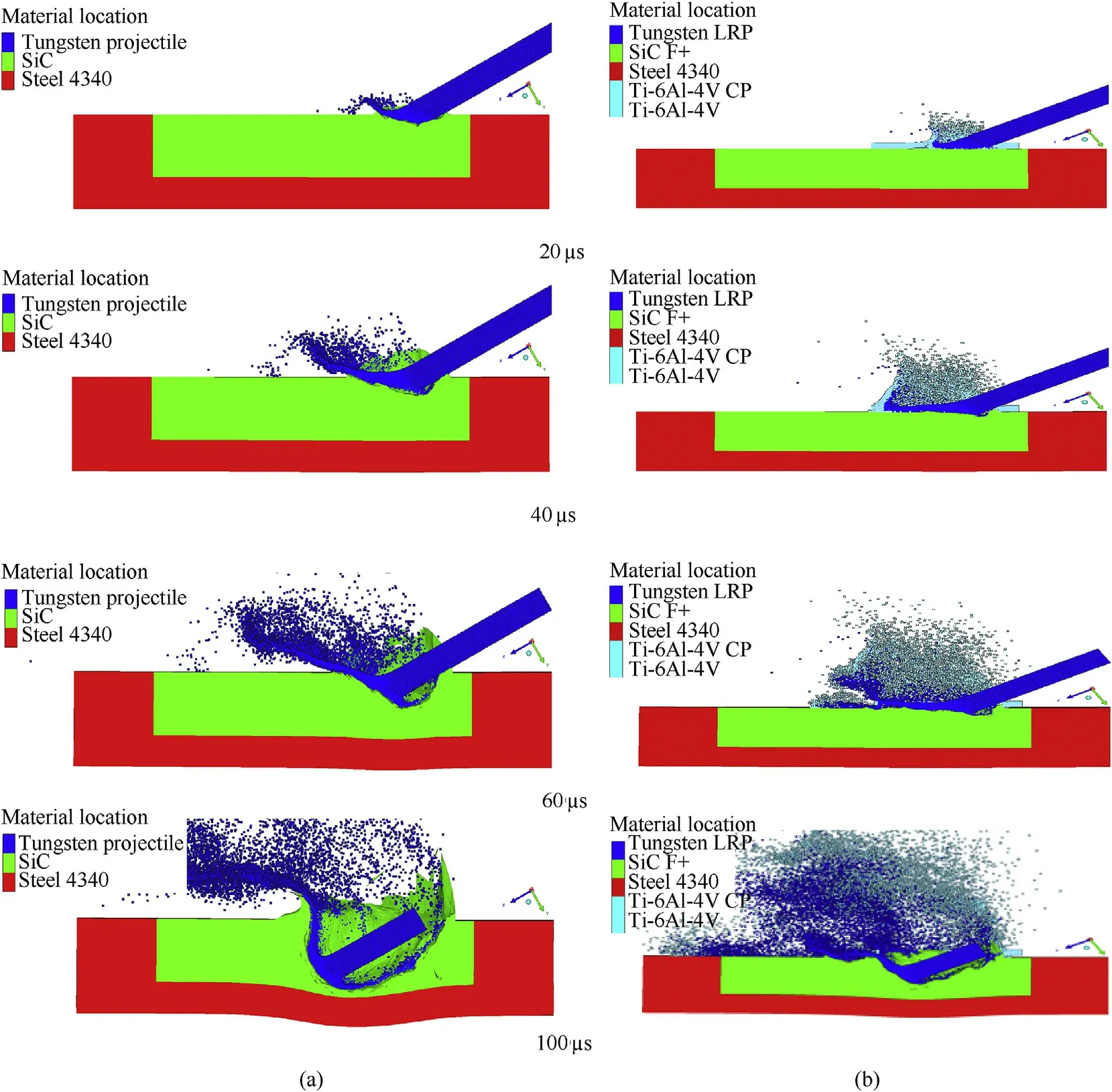
Fig.A 4.Projectile penetration at different times for oblique impact of LRP of 1196 m/s initial velocity onto armor of fixed SiC tile thickness,t SiC=20 mm,BP thickness,t b=10 mm,(a)without buffer and interlayer and,(b)with t Ti64=2 mm(front cover plate),t Ti64=1 mm(interface weak layer).
Fig.A 5 illustrates the penetration mechanism of armor under oblique impact scenario.It can be seen that as the penetration in the ceramic begins,the LRP changes its penetration path due to excessive material and displace the fragmented ceramic.The ceramic particle,though fragmented,ahead of the LRP flow radially around the LRP and simultaneously eroding the LRP.This process continues until the LRP erodes completely or restraints it by dispersing its kinetic energy.
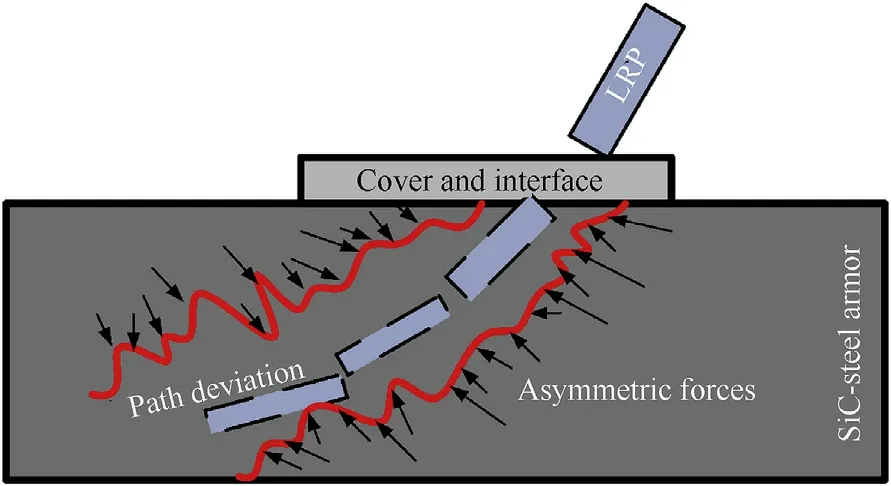
Fig.A 5.Schematic of Oblique Impact.
杂志排行
Defence Technology的其它文章
- High explosive unexploded ordnance neutralization-Tallboy air bomb case study
- Dynamics and rebound behavior analysis of flexible tethered satellite system in deployment and station-keeping phases
- Finite element analysis of functionally graded sandwich plates with porosity via a new hyperbolic shear deformation theory
- Investigation on the penetration of jacketed rods with striking velocities of 0.9-3.3 km/s into semi-in finite targets
- The effect of strain rate on compressive behavior and failure mechanism of CMDB propellant
- Adaptive target and jamming recognition for the pulse doppler radar fuze based on a time-frequency joint feature and an online-updated naive bayesian classi fier with minimal risk
